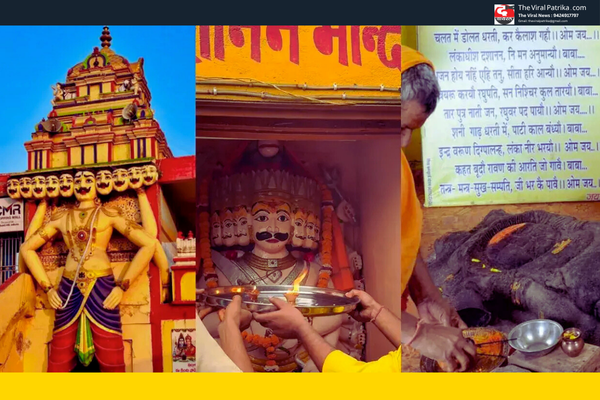Introduction:
Dussehra, also known as Vijayadashami, is celebrated across India as the day when Lord Ram defeated the demon-king Ravan, marking the victory of good over evil. The highlight of the festival is the burning of Ravan’s effigies, symbolizing the destruction of arrogance and vice.
Yet, in a few parts of India, the story takes a very different turn. Here, Ravan is not considered the villain but remembered as a great scholar, a mighty devotee of Lord Shiva, and even a revered ancestor or son-in-law. As Dussehra 2025 approaches, let’s explore the towns and villages where Ravan is worshipped instead of burned.

Bisrakh, Uttar Pradesh: Ravan’s Birthplace:
Just outside Greater Noida lies Bisrakh village, believed to be the birthplace of Ravan. Locals here consider him the “Maha Brahman.” Unlike other regions, Dussehra in Bisrakh is not about fireworks or effigy burning—it is a solemn remembrance.
- Rituals and yajnas (fire sacrifices) are performed during Navratri in his honor.
- Villagers believe burning Ravan’s effigy would count as Brahm Hatya (killing of a Brahmin) and bring misfortune.
- Instead, they honor him as a wise scholar and son of the soil.
Kanpur, Uttar Pradesh: The Dashanan Temple:
- Worshippers chant “Jai Lankesh” and “Lankapati Naresh ki Jai.”
- Ravan is venerated as a loyal devotee of Lord Shiva and Goddess Chinmastika.
- The temple is one of the rare places in India where Ravan has his own dedicated idol.
In Kanpur’s Shivala locality, stands the Dashanan Temple—a unique shrine dedicated to Ravan. The temple is closed for most of the year, its idol veiled from sight. But on Dussehra, it opens its doors for devotees.Just outside Greater Noida lies Bisrakh village, believed to be the birthplace of Ravan. Locals here consider him the “Maha Brahman.” Unlike other regions, Dussehra in Bisrakh is not about fireworks or effigy burning—it is a solemn remembrance.
Ravangram, Madhya Pradesh: Ravan as Ancestor:
In Vidisha district, the village of Ravangram takes pride in its connection to Ravan. The village houses a massive reclining statue of the demon-king, nearly ten feet long.
- Locals call him “Ravana Baba” and salute with the phrase “Namah.”
- They believe they are direct descendants of Ravan’s family.
- In a unique custom, Ravan is the first to be invited to every wedding in the village, symbolizing respect for their ancestor.
Mandsaur, Madhya Pradesh: Ravan as Son-in-Law
The town of Mandsaur, located on the border of Madhya Pradesh and Rajasthan, holds special significance as it is believed to be the hometown of Mandodari, Ravan’s wife.
- This makes Ravan a revered son-in-law (sasural) of the region.
- Tall statues and temples in Mandsaur celebrate his memory.
- During Dussehra, locals pay respects through prayers rather than burning effigies.
Kakinada, Andhra Pradesh: The Devotee of Shiva:
In coastal Kakinada, Andhra Pradesh, Ravan is honored for his deep devotion to Lord Shiva. The city houses the Kumbhabhishekam Temple, one of the only Ravan temples in the state.
- It is believed that Ravan himself chose the location for the Shiva Temple here.
- On Dussehra, devotees remember him as a symbol of unwavering faith and scholarship.
Conclusion:
While most of India celebrates Dussehra by burning Ravan’s effigies, these towns and villages remind us of his other dimensions—a scholar, a devout worshipper, an ancestor, and even a son-in-law. Dussehra 2025 is not just about the destruction of evil but also about acknowledging the diverse cultural narratives that exist within India.
This unique blend of reverence and rejection makes Ravan one of the most complex figures in Indian mythology.
EXCLUSIVE VIRAL NEWS:



